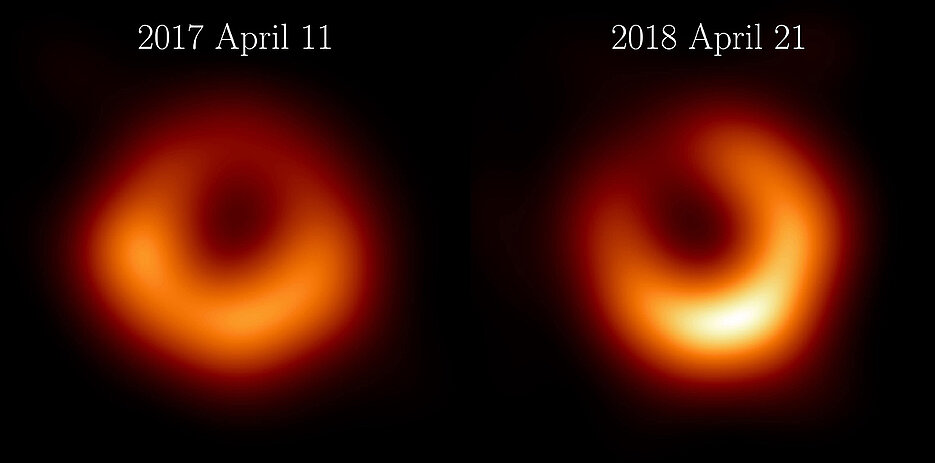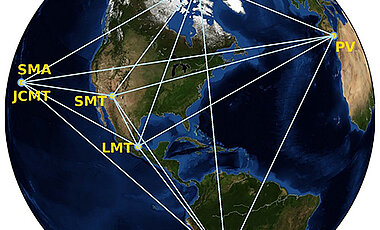Scientists Reveal a Black Hole Shadow
01/19/2024One year after the discovery image of the black hole M87*, improved observations of the Event Horizon Telescope (EHT) Collaboration give a better picture showing a persistent black hole shadow.

The Event Horizon Telescope (EHT) Collaboration including scientists at Julius-Maximilians-Universität (JMU) Würzburg has released a new image of M87*, the supermassive black hole residing at the heart of the galaxy Messier 87. This latest revelation builds upon the historic 2019 release, marking the first-ever image of a black hole. The latest observation campaign showcases a persistent black hole shadow, offering crucial insights into the nature of M87*.
The new image, captured with an improved telescope array and a broader frequency coverage, reveals a ring with a southerly peaked brightness distribution, akin to the former image, but with a subtle difference: a remarkable shift in the brightness asymmetry, rotated by approximately thirty degrees, has been identified.
The research is published in the present issue of the Astronomy & Astrophysics journal.
Würzburg Researchers Make a Crucial Contribution
In the pursuit of unraveling the enigmatic nature of supermassive black holes, the computational astrophysics group at Julius-Maximilians-Universität (JMU) Würzburg has been conducting its groundbreaking research on M87* under the leadership of Christian M. Fromm.
“We develop state-of-the art numerical simulations and employ our own super-computing infrastructure to model and interpret the EHT observations of M87*. Only the combination of simulations and observations of M87*, provides us with new deep insight into the physics of black holes and accretion disks”. These activities are supported through the DFG research unit “Relativistic Jets in Active Galaxies”, which is coordinated from the JMU Chair for Astronomy.
“A fundamental requirement of science is to be able to reproduce results,” says Keiichi Asada, an associate research fellow at Academia Sinica Institute for Astronomy and Astrophysics in Taiwan. “Confirmation of the ring in a completely new data set is a huge milestone for our collaboration and a strong indication that we are looking at a black hole shadow and the material orbiting around it.”
The Beating Heart of a Giant Galaxy
In 2017, the EHT obtained the first image of a black hole, revealing M87* as the beating heart of a giant elliptical galaxy, located 55 million light-years from Earth. This first image, published in 2019, shows a bright circular ring, brighter in the southern part of the ring. Further analysis of the data also revealed the structure of M87* in polarized light, giving us greater insight into the geometry of the magnetic field and the nature of the plasma around the black hole.
To enhance observing capabilities, the Greenland Telescope joined the EHT in 2018, just five months after its construction was completed. The Greenland Telescope is located far above the Arctic Circle, providing improved image fidelity and increased angular resolution in the north-south direction. The Large Millimeter Telescope in Mexico also participated for the first time with its full 50-metre surface, greatly improving its sensitivity.
In 2018, the EHT array was also upgraded to observe in four frequency bands around 230 GHz, compared to only two bands in 2017. Despite the challenges posed by weather conditions during the 2018 observations, advances in data acquisition and calibration techniques ensured high-quality results.
The analysis of the 2018 data, using eight independent imaging and modeling techniques, reaffirms the stability of the diameter of the black hole shadow, consistent with general relativistic predictions. However, a significant change in the location of the brightest region around the ring shows turbulence breaking the symmetry, combined with a dynamic interplay between the black hole's spin axis and the large-scale jet.
Leading Groups in Bonn, Frankfurt, and Würzburg
“Germany is a key player in the international EHT effort” says JMU Astrophysics Professor Matthias Kadler who is a member of the EHT collaboration but was not directly involved in the M87* study. “Through the Max Planck Society, Germany operates the 12-m APEX telescope in Chile and is a major partner in the operation of the 30-m telescope on Pico Veleta, two facilities that are central to the success of the EHT. German groups in Bonn, Frankfurt and Würzburg are leading various EHT projects, specializing in the design of observations, the imaging and calibration of the data, as well as its modeling and interpretation.” Members of the EHT collaboration in Würzburg are Matthias Kadler, Christian Fromm, and postdoctoral fellow Luca Ricci.
Publication
Event Horizon Telescope Collaboration, The persistent shadow of the supermassive black hole of M 87. I. Observations, calibration, imaging, and analysis, Astronomy & Astrophysics, 18 January 2024, doi: 10.1051/0004-6361/202347932. Open Access https://doi.org/10.1051/0004-6361/202347932
Weblinks
Event Horizon Telescope (EHT) https://eventhorizontelescope.org/
DFG Research Unit “Relativistic Jets in Active Galaxies” https://www.for5195.uni-wuerzburg.de/
ERC Project Black Hole Cam (BHT) https://blackholecam.org/
Contact at JMU
Dr. Christian M. Fromm, Staff Scientist, Research Group Leader Computational Astrophysics, University of Wuerzburg, Institute for theoretical Physics and Astrophysics, Phone: +49 931 31-81981, christian.fromm@uni-wuerzburg.de







